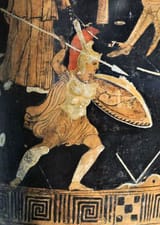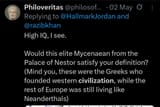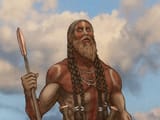Anonymous
7/13/2025, 12:52:50 PM No.17837942
The Argives mentioned in the Illiad originally refered to the inhabitants of Pelasgian Argos, the earlier name for Thessaly, this becomes clear upon reading the Thessalian section of the catalogue of ships (universally agreed to be the oldest part of the poem) in Greek, aswell as noting the sheer overrepresentation of Thessalians in the expedition.
Peleponesian Argos was irrelevant in Mycenaean times and was a backwater during the dark ages, but was conveniently the dominant force in Greece in Homer's days, meaning the refrences to Argos the city as important is likely an anachronism, same as with Sparta.
The political structure of the Mycenaean kingdoms also don't match what we see in the Illiad at all, but it does closely resemble the koine structure of the Thessalian leauge from the classical and Archaic periods with the Tagus as military leader. The theory also explains how Thebes was sacked (which we know happened in the late bronze-age) by the Epigoni, who couldn't possible have come from Argos(which wasn't even a major center yet) as the later mythographer clam and probably not Mycenae either since the Mycenaean kingdoms in general don't seem to have been very expansionistic. Finally this explains why so many of the Greek heroes are described as having fair features even though we know from depictions and now genetic testing that the late Mycenaeans were quite dark, the heroes were originally from northern Greece and some of them were reimagined as rulers of the larger centers down south during the Dark-age migrations.
Peleponesian Argos was irrelevant in Mycenaean times and was a backwater during the dark ages, but was conveniently the dominant force in Greece in Homer's days, meaning the refrences to Argos the city as important is likely an anachronism, same as with Sparta.
The political structure of the Mycenaean kingdoms also don't match what we see in the Illiad at all, but it does closely resemble the koine structure of the Thessalian leauge from the classical and Archaic periods with the Tagus as military leader. The theory also explains how Thebes was sacked (which we know happened in the late bronze-age) by the Epigoni, who couldn't possible have come from Argos(which wasn't even a major center yet) as the later mythographer clam and probably not Mycenae either since the Mycenaean kingdoms in general don't seem to have been very expansionistic. Finally this explains why so many of the Greek heroes are described as having fair features even though we know from depictions and now genetic testing that the late Mycenaeans were quite dark, the heroes were originally from northern Greece and some of them were reimagined as rulers of the larger centers down south during the Dark-age migrations.
Replies:



